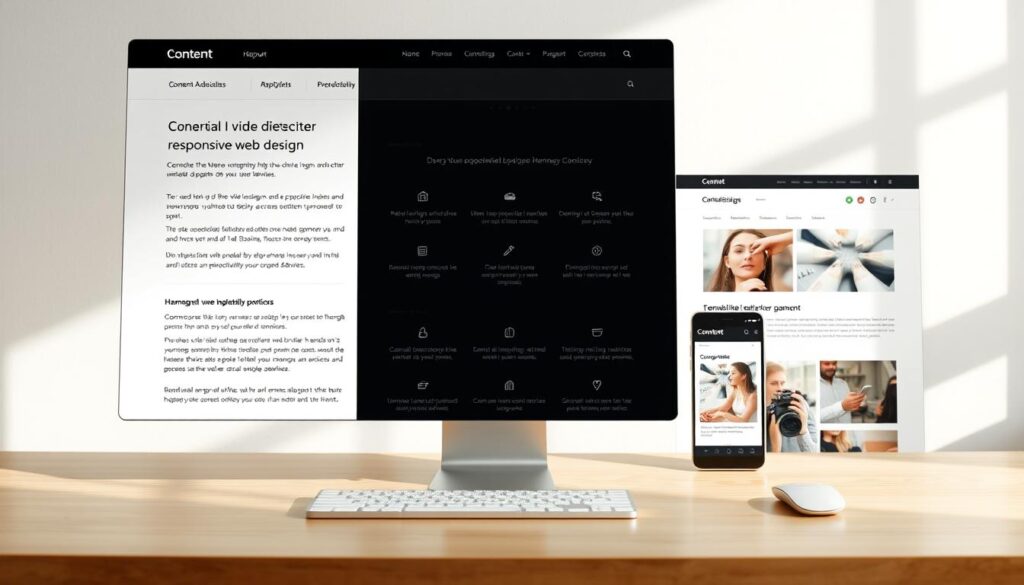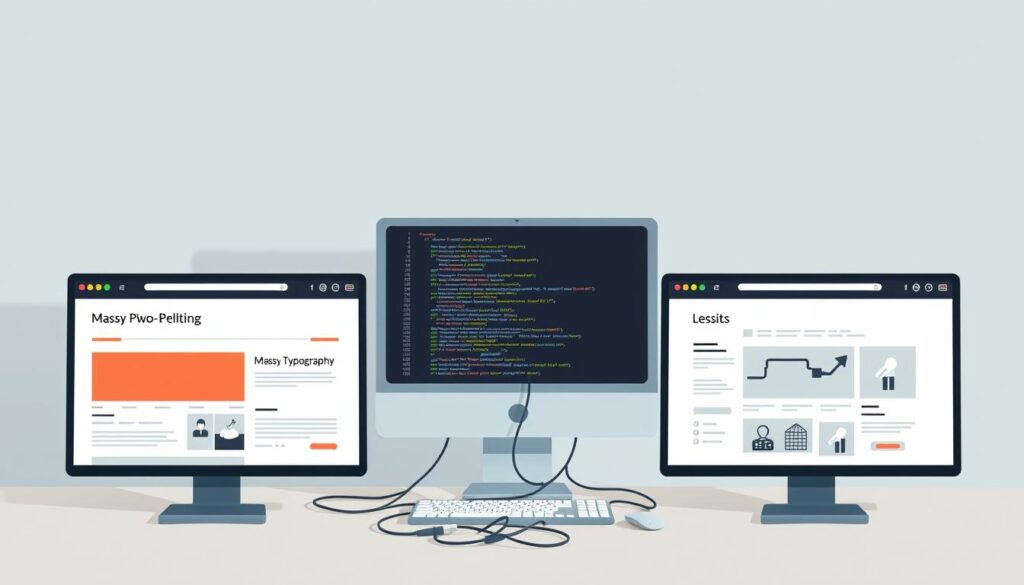Building a DIY website can help you get online, but it’s easy to make mistakes. Many people face issues like poor mobile performance, bad navigation, and ignoring SEO. These errors can harm your site’s success and credibility.
Mobile traffic is huge, making up 50% of all web visits globally. Every extra second in load time can cost 4% in conversions. With 67% of buying journeys happening online, it’s key to avoid these mistakes. You need a site that looks good and works well to attract and keep customers.
Key Takeaways
- Avoiding diy website mistakes to avoid is key for success online
- Poor mobile performance can lose you visitors
- Bad navigation and user experience can lower conversion rates
- Ignoring SEO can hurt your search rankings and traffic
- Regular updates can boost engagement by up to 50%
- Common diy website errors can cut customer conversions by 50%
- Focus on professional design and branding to avoid pitfalls
Understanding the Impact of DIY Website Mistakes to Avoid
Many people and businesses choose to make their own websites to save money and time. But, this can lead to mistakes that hurt the website’s performance and user experience. By knowing the value of professional websites and following best practices, you can steer clear of these errors and make your site successful.
A well-designed website builds trust and can boost sales. Studies show that a professional-looking site can greatly impact how users see a brand. By avoiding common mistakes and following best practices, you can make a website that looks good and works well.
Creating a successful website means having a clear navigation, fast-loading images and content, and being mobile-friendly. By planning and designing your website carefully, you can avoid mistakes and make a site that meets your needs and goals.
Here are some key statistics to consider when creating a website:
- 50+ items are typically included in a website design checklist across several stages of a project.
- A website is legally required to have a Privacy Policy, and failing to do so can result in legal violations.
- Websites should provide easy access to contact information, including email addresses and office hours, to facilitate communication.
By understanding the importance of professional-looking websites and following best practices, you can avoid common mistakes. This way, you can create a website that is both effective and engaging.
Poor Mobile Responsiveness: A Critical Oversight
More than 50% of all web traffic comes from mobile devices. It’s key to make sure your website works well on mobile. A slow or non-mobile-friendly site can make visitors leave quickly. In fact, a one-second delay can cause a 20% increase in bounce rates.
Mobile responsiveness is now a must, not just a nice-to-have. Google uses mobile-friendliness as a ranking factor. This means sites not optimized for mobile might see their visibility drop. To prevent this, focus on making your site mobile-friendly. This means designing a site that changes to fit different screens and devices.
Some important stats about mobile responsiveness include:
- 57% of users say they won’t recommend a business with a poorly designed mobile site
- Mobile-friendly websites can see conversion rates increase by up to 160% compared to non-optimized sites
- 72% of users prefer a mobile-friendly website that adapts to their device over a non-responsive one
By focusing on mobile responsiveness and avoiding commonavoidable website mistakesandwebsite development errors, you can enhance user experience. This can also lead to higher conversion rates and better online visibility.
Navigation and User Experience Blunders
Creating a website can be tricky. One key area is navigation and user experience. A bad design can make people leave their shopping carts. Studies show up to 70% of shoppers do this because of poor design.
Common mistakes include confusing menus, broken links, and uneven layouts. These issues can make visitors leave. To avoid this, make your website easy to navigate and consistent in design.
Here are some tips to help you avoid common navigation and user experience blunders:
- Keep your menu structure simple and easy to navigate
- Use clear and concise language in your menu and throughout your website
- Ensure that all links are working correctly and not leading to dead ends
- Use a consistent layout throughout your website to create a cohesive user experience
By avoiding these common web design blunders and creating a user-friendly website, you can boost your site’s performance. A well-designed website is key to online success. By focusing on good design, you can attract and engage your audience.
Neglecting Essential SEO Practices
Building a website can be exciting, but it’s easy to miss important SEO practices. These mistakes can hurt your website’s visibility. Search engines use SEO to rank websites, and ignoring it can lower your site’s ranking.
More than half of all website visits come from search engines. This makes SEO key for your website’s success.
One big mistake is using too many keywords. This can get you in trouble with search engines. Instead, aim for quality content that naturally includes the right keywords. This approach can boost your site’s ranking and attract more visitors.
Here are some important SEO tips to remember:
- Do keyword research to find topics with enough search interest.
- Use H tags to help search engines understand your content’s structure.
- Link to other relevant pages on your site to improve navigation.
Focus on SEO to enhance your website’s online presence. Use tools like Google Analytics to see how well your SEO is working. This way, you can make your site more visible and attract more visitors.
Slow Loading Speed and Performance Issues
Slow loading speed and performance issues are big problems in website creation. Google says a page should load in under 2.5 seconds to be fast. Slow pages and hard-to-use sites can lose customers and increase bounce rates.
Common causes include image problems, server speed, and too many plugins. 
Image Optimization Problems
Big images can slow down websites because they use a lot of bandwidth. Compressing images can make them up to 60% smaller, speeding up loading times.
Server Response Time Concerns
Browser caching can make pages load almost 2 seconds faster. Using tools like GNU Gzip can also make data transfer faster, speeding up loading times.
Plugin Overload Consequences
Too many plugins and ads can slow down websites. Fixing these mistakes by optimizing code and reducing plugins can help.
By fixing these common mistakes, you can make your website faster and better. This will help keep users happy and increase sales.
Security Vulnerabilities in DIY Websites
Security issues are a big problem for DIY websites. They can lead to serious problems like cyber attacks. These attacks can cost a lot, up to £25,700, in ransoms and replacing hardware.
Common mistakes include outdated software and weak passwords. It’s important to use strong passwords with letters, numbers, and symbols. Also, keep an eye on your DNS and WHOIS listings to avoid domain theft.
To keep your site safe, do regular security checks and use two-factor authentication. These steps help avoid mistakes that can harm your site’s security.
- Regularly updating plugins and software
- Using strong, unique passwords
- Implementing SSL Certificates
- Monitoring DNS and WHOIS listings
- Performing regular vulnerability scans and penetration testing
Content Organization and Hierarchy Mistakes
Building a DIY website means you must think about how you organize your content. A well-organized site makes it easier for users to find what they need. This can lead to more people buying from your site.
Many DIY website builders make common diy website errors. These include poor content structure and unclear calls-to-action. These mistakes can make visitors leave quickly. To fix this, focus on clear messages, easy navigation, and a consistent design.
Here are some tips to avoid diy website mistakes to avoid:
- Make a clear content hierarchy to guide users
- Use the same branding elements for a unified look
- Optimize images and reduce clutter for faster loading
- Use clear calls-to-action to encourage action

By avoiding common mistakes, you can make a site that looks good and works well. A well-organized website is key to success online. Focus on these areas to make your site successful.
Visual Design and Branding Missteps
A well-designed website makes a great first impression. It shows confidence to visitors. But, many DIY sites make common mistakes. These include pixelated images, too much color, and not enough white space.
These errors can hurt professionalism and user experience. They might even push away customers.
To avoid these mistakes, it’s key to have a clear design hierarchy. Guide visitors smoothly through your site. And, keep a professional look.
Stick to 2-3 fonts and 2-3 colors for a simple, cohesive design. Properly align text and images for a polished look.
Also, changing your brand too often can confuse people. But, consistent branding can boost revenue by up to 23%. Focus on appealing to your audience and follow design basics to attract and engage customers.
By watching out for these common mistakes and following best practices, entrepreneurs can build a strong online presence. This can help their business succeed.
Conclusion: Building a Professional Website That Works
Creating a professional website needs careful planning and execution. It’s important to avoid common website creation missteps. By focusing on mobile responsiveness, navigation, and user experience, you can attract and convert customers.
Recent data shows that a professional website can help you reach your online goals. It can also increase conversions and sales.
Avoiding avoidable website mistakes is key to building trust with your audience. Research finds that 94% of users distrust websites due to design issues. A well-designed website can boost user trust and engagement, leading to better conversion rates.
With most website traffic coming from mobile devices, it’s vital to make sure your website is mobile-friendly. It should also load quickly.
To build a professional website that works, consider these key elements:
- Mobile responsiveness
- Easy navigation and user experience
- Search engine optimization (SEO)
- Visual design and branding
By focusing on these elements and avoiding common mistakes, you can create a website that helps you achieve your online goals. It will also increase conversions and sales.
Call to Action
DIY website creation might seem cheap, but it’s not always the best choice. Working with professional web designers is key for lasting online success. They can make your site look professional and draw in customers.
A good website makes users happy and boosts sales. Studies show a strong call-to-action (CTA) can increase clicks by 200-300%. This is a big deal for your business.
Don’t miss out on chances to grow your business. Reach out to us to see how our web design can help. We’ll make sure your site works well on all devices, has smart CTAs, and uses SEO to attract more visitors. Let’s build a website that makes you stand out online.

